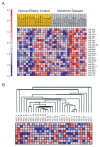MicroRNA expression in Alzheimer blood mononuclear cells
- PMID: 19936094
- PMCID: PMC2759133
- DOI: 10.4137/grsb.s361
MicroRNA expression in Alzheimer blood mononuclear cells
Abstract
Various coding genes representing multiple functional categories are downregulated in blood mononuclear cells (BMC) of patients with sporadic Alzheimer disease (AD). Noncoding microRNAs (miRNA) regulate gene expression by degrading messages or inhibiting translation. Using BMC as a paradigm for the study of systemic alterations in AD, we investigated whether peripheral miRNA expression is altered in this condition. MicroRNA levels were assessed using the microRNA microarray (MMChip) containing 462 human miRNA, and the results validated by real time PCR. Sixteen AD patients and sixteen normal elderly controls (NEC) were matched for ethnicity, age, gender and education. The expression of several BMC miRNAs was found to increase in AD relative to NEC levels, and may differ between AD subjects bearing one or two APOE4 alleles. As compared to NEC, miRNAs significantly upregulated in AD subjects and confirmed by qPCR were miR-34a and 181b. Predicted target genes downregulated in Alzheimer BMC that correlated with the upregulated miRNAs were largely represented in the functional categories of Transcription/Translation and Synaptic Activity. Several miRNAs targeting the same genes were within the functional category of Injury response/Redox homeostasis. Taken together, induction of microRNA expression in BMC may contribute to the aberrant systemic decline in mRNA levels in sporadic AD.
Keywords: Alzheimer disease; gene expression; microarray; neurodegeneration; noncoding small RNA.
Figures



References
-
- Ambros V. The functions of animal microRNAs. Nature. 2004;431:350–5. - PubMed
-
- Bilen J, Liu N, Bonini NM. A new role for microRNA pathways: modulation of degeneration induced by pathogenic human disease proteins. Cell Cycle. 2006a;5:2835–8. - PubMed
-
- Bilen J, Liu N, Burnett BG, Pittman RN, Bonini NM. MicroRNA pathways modulate polyglutamine-induced neurodegeneration. Mol Cell. 2006b;24:157–63. - PubMed
-
- Boehm M, Slack F. A developmental timing microRNA and its target regulate life span in C. elegans. Science. 2005;310:1954–7. - PubMed
LinkOut - more resources
Full Text Sources
Other Literature Sources
Research Materials

